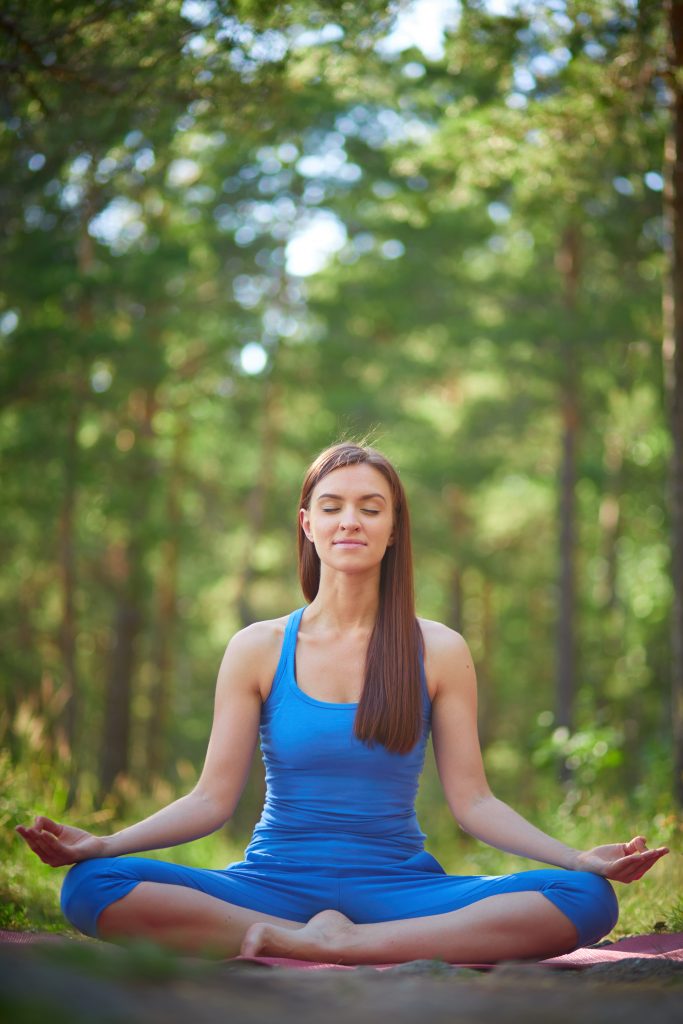Grounding Yourself Like A Tree
The posture you take when meditating is a vital part of the practice – both to keep your mind alert, and also to put your body back in alignment.
Whether you come into a meditative practice for the emotional benefit of increased mindfulness or the physical benefit of counteracting the toll stress takes on your body, the way you sit is vitally important to how you feel during and after meditation.
If you examine the meditation poses depicted in the world’s great spiritual traditions, you’ll find that they all have one thing in common — the unshakable stability of a mountain or tree. Look at the kneeling pharaohs in the Egyptian pyramids, for example, or the cross-legged Buddhas in Indian caves or Japanese temples. They sit on a broad base that appears to be deeply rooted in the earth, and they have a grounded presence that says, “I can’t be budged. I’m here to stay.”
When you sit up straight like a mountain or a tree, your body acts as a link between heaven and earth — and by analogy, connects your physical, embodied existence with the sacred or spiritual dimension of being. In addition to the spiritual aspect, you might consider that sitting up straight confers some practical benefits as well. By aligning the spine and opening the channels that run through the center of the body, upright sitting encourages an unimpeded circulation of energy, which, in turn, contributes to wakefulness on all levels — physical, mental, and spiritual. Besides, it’s a lot easier to sit still for extended periods of time when your vertebrae are stacked like a pile of bricks, one on top of the other. Otherwise, over time, gravity has this irritating habit of pulling your body down toward the ground — and in the process, causing the aches and pains so typical of a body at war with the forces of nature. So, the most comfortable way to sit in the long run is straight, which puts you in harmony with nature.
Of course, you can always lean against the wall — or so you may think. But your body tends to slouch when it leans, even subtly, in any direction; and the point of doing meditation is to rely on your direct experience, rather than to depend on some outside support to “back you up.” When you sit like a mountain or a tree, you’re making a statement: “I’m deeply rooted in the earth, yet open to the higher powers of the cosmos — independent, yet inextricably connected to all of life.”
– via www.dummies.com
It’s More Than Just Your Back
Your posture isn’t just about how straight your back stays during meditation. Good meditative posture means involving your whole body, from the set of your jaw to the placement of your hands. Taking the time – even just a few minutes per day – to focus on your body, on your breathing, and on clearing your mind, could go a long, long way toward stress reducing mindfulness.
Below are some of the “Points of Posture” to make the most of your meditation. The first Point is sitting down – once you sit down, what’s next?
Second Point of Posture: Elongate the Spine
Having established this firm foundation it is important to lift yourself up through your spine. Traditional analogies say that your spine should be like an arrow or a stack of coins, one on top of the other. It is as if a rod could go through the top of your head and down through your bottom. You want to feel uplifted when you sit down to meditate.
Third Point of Posture: Resting Your Hands
The simplest thing to do with your hands is to rest them on your lap. You can drop your hands at your sides and pick them up at the elbow then drop them palms down on your thighs. This is a natural axis point on which to rest them, providing better support for your upright spine. In his new book The Relaxed Mind, Kilung Rinpoche mentions that sitting with your palms down tends to relax the flow of energy throughout your body.
Alternatively, you can place your right hand on top of your left with your thumbs very lightly touching, resting them on your lap at your navel. Kilung Rinpoche has remarked that this creates more heat and energy in the body, which can be useful if you are feeling sleepy. Symbolically, the left hand represents wisdom and the right compassion. In this gesture you are bringing the two together.
Fourth Point of Posture: Relaxing the Shoulders
Let the muscles in your shoulder and back relax. Your shoulders can be pushed slightly back. This establishes a strong back while opening up the front body. There is a touch of vulnerability in this point of posture as we expose our tender heart.
Fifth Point of Posture: Tucking in the Chin
Slightly tuck in your chin. You don’t want to go so far that you are looking directly down at your lap but you don’t want your head held so far upwards that it may tire you out.
Sixth Point of Posture: Opening the Jaw
Bring a sense of relaxation to the muscles in your face so that your jaw hangs open. Place the tongue up against the roof of your mouth to allow for clear breathing and slow down the swallowing process, which can at times be distracting.
– via Yoga Journal
Have you tried meditation for stress reduction? What posture do you use when meditating?